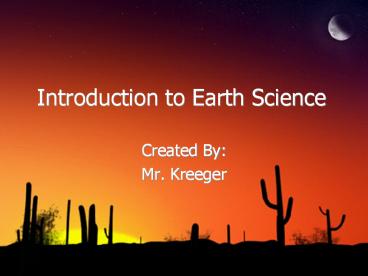Introduction to Earth Science - PowerPoint PPT Presentation
1 / 20
Title: Introduction to Earth Science
1
Introduction to Earth Science
- Created By
- Mr. Kreeger
2
Homework and Page References
- Page References
- Text- Pages 3-6
- HW
- 1-5 on page 6, complete handouts
- When do you think science begin support your
reasoning with concrete examples
3
Table of Contents
- Definition of Earth Science
- Branches of Earth Science
- Discussion topics
- Ecology
- Observation and Measurement
- Units of Measurements (handout)
- Exponential Notation
- Observation vs. Inference (handout)
4
Introduction Video
Earth Science
5
1. Earth Science Defined
- Earth Science is the study of the Earth and the
Universe around it.
6
2. Branches of Earth Science
- Geology- Study of the origin, history and
structure of the solid earth and the processes
that have shaped it.
7
Discussion and Ideas associated with Geology
- Why do we constantly need to find new deposits of
coal, oil and gas? - Why is important to understand volcanoes and
Earthquakes? - Why is it so important to understand the origin
of fossils?
8
2. Branches of Earth Science Cont.
- Meteorology- The study of the earths atmosphere
by use of satellites and radar.
9
Discussion and Ideas associated with Meteorology
- Why is it so important to make accurate
forecasts? - What is a cycle, give some examples?
- Why is it important to find examples in weather
forecasting or science in general?
10
2. Branches of Earth Science Cont..
- c. Oceanography- The study of the Earths oceans.
11
Discussion and Ideas associated with Oceanography.
- Why is it important to investigate the ocean
floor. - Why is it important to look at how water moves
throughout the oceans, what effect can it have on
mankind?
12
2. Branches of Earth Science Cont..
- Astronomy- Study of the universe beyond the earth
(oldest branch of Earth Science)
13
Discussion and Ideas associated with Astronomy
- Do you think it is important to venture to other
planets in the solar system. Justify your
answer.. - What do we have to gain by looking and
understanding comets and asteroids?
14
3. Ecology
- This is the study of the complex relationships
between living things and the environment. - Parts of the world
- Geosphere- Solid Earth
- Hydrosphere- water
- Atmosphere- Gases that surround earth
- A community of organisms and their environment is
called and ecosystem largest one is biosphere
15
How the Earth has Changed
Changing Earth
16
Observation and Measurements
- What are some ways that we observe the world
around us? - By use of our 5 senses
- Instruments are used to make our observations
more accurate. Some examples are - Balance, thermometers, and meter sticks
17
Units of Measurement (Metric Versus American
Units)
- Measurements must have units.
- A NUMBER WITHOUT UNITS IS MEANINGLESS
Basic Units American Metric
Length Foot (ft) Meter (m)
Mass Pound (lb) Kilogram (kg)
Time Second (s) Second (s)
Units Handout
18
Exponential Notation
- Useful for working with very large or small
numbers - M x 10n (Where M is a number from 1 to 10 but
cant be 10, and n is a power of 10) - Ex 1 2500--gt 2.5 x 103 (2.5 x 1000)
- Ex 2 .002500--gt 2.5 x10-3 (2.5 x .001)
- Numbers lt 1 written with negative exponent
- Numbers gt 1 written with positive exponent
19
Exponential Notation Practice
Write in exponential Form Write in standard form
61,500 1.09 x 103
0.0000568 4.22715 x 108
321 3.078 x 10-4
64,960,000 9.004 x 10-2
0.07085 5.1874 x 102
20
Observation vs. Inference
- Observations are things that actually happened
- Inferences are things that you think are
happening, or may happen
Obs/ Inf handout

